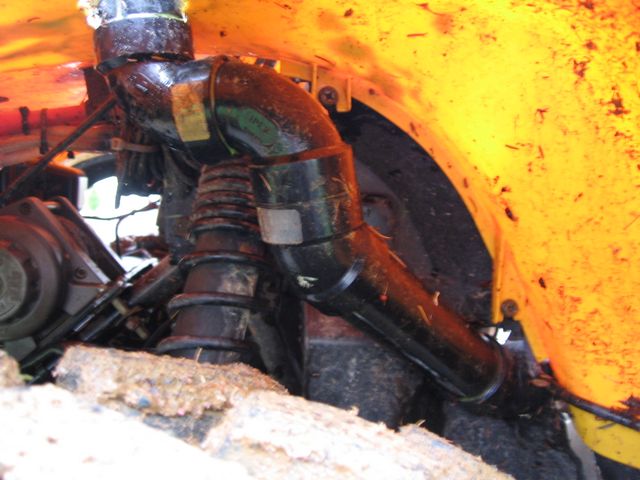This project will cover the preparation of
my Foreman ATV for deep water crossing. This project will include
the fabrication and installation of an engine air intake snorkel,
and some other tips/tricks to to help in deep water crossing. This
article is just my opinion and not gospel on this subject, so take
my advise at your own discretion and ride at your own risk. Before
riding deep water even on a non-modified bike, read your owners
manual and find the air box, carburetor, drive belt housing drain
locations, locate the spark plug (plugs if a twin cylinder) and
learn how to remove them with tools stored on your bike - ALL BEFORE
LEAVING YOUR HOUSE.
The Honda Foreman 450 has a factory intake snorkel that takes in air next to the
gas tank at about the height of the word "Foreman" on the plastics.
It works well for most people in stock form, but I wanted the assurance of a dry
crossing for deeper water. After completing some research online in June 2005, I came up with
a plan and was off to the plumbing store to pick up some 1.5" ABS pipe,
fittings and glue.
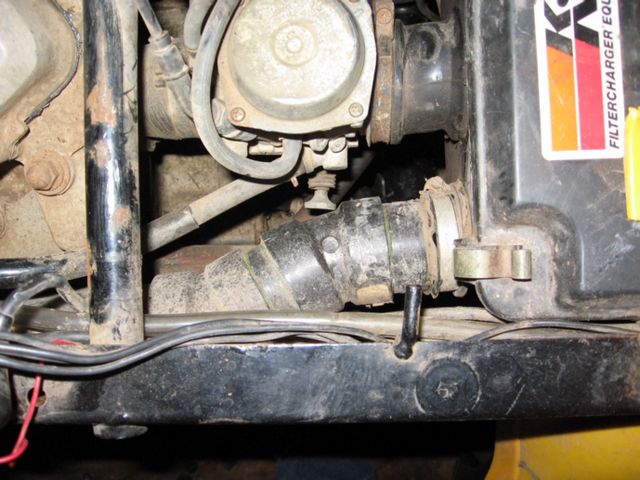
I started by removing the gas tank cover
and removing the factory
snorkel. The next task was to mill down a short piece of ABS pipe to exactly
match the diameter of the stock snorkel where it enters the air box. Once the new pipe
fit snugly I coated the end with Silicone Gasket maker and installed it with the
factory rubber seal and clamp. Next a series of 22.5 degree couplers were used
to route the pipe around the engine then it was a straight shot to the left
front fender area.
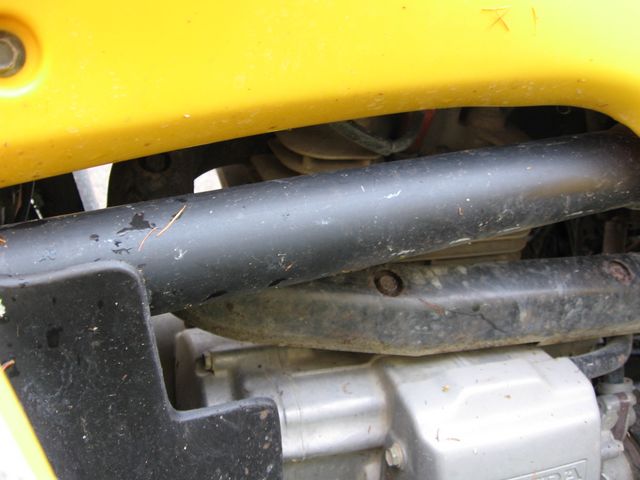
Another series of couplers routed the pipe
through the wheel well staying clear of the tire, up through the fender and through the Front
Rack.

Once the pipe came through the fender and the rack, I fabricated a mount from
galvanized sheet metal to secure the snorkel to the front rack. I cut a hole
the same diameter as the pipe in the middle of the tin, and sandwiched the metal
between a straight coupler on the bottom and a female threaded coupler on the
top. The plate was then attached to the
rack and painted black.
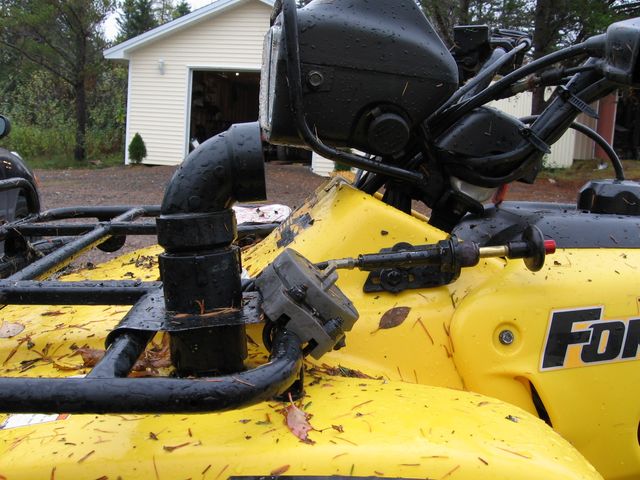
The reason I used a threaded coupler on top of the mounting plate
was so that I can screw in a short snorkel for everyday riding and a
longer one for planned deep water crossings. Using a long snorkel
all the time makes the system less sturdy on rough trails, and is
directly in the view of the rider.
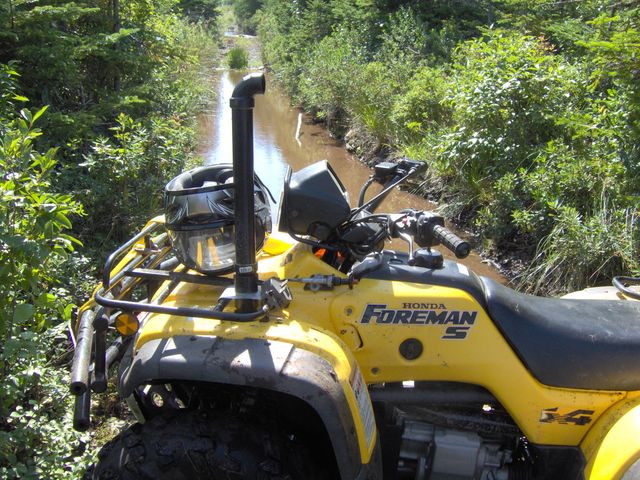
Both of my snorkels have a 90 degree fitting at
the top to suppress rain, snow or splashing water from entering the
intake.
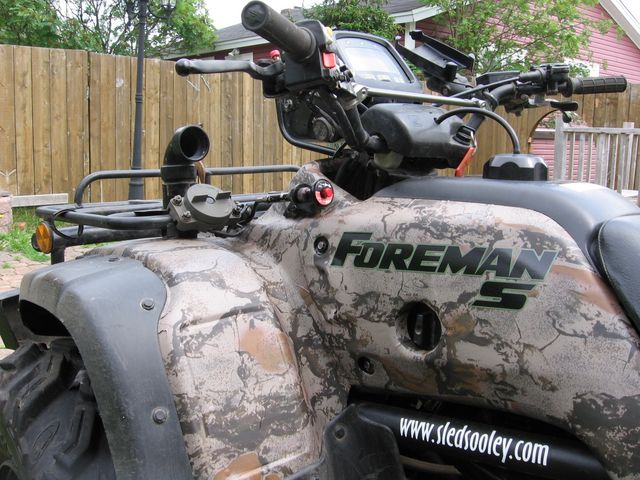
There is no exact science to this process as every bike is different, it took
some trial and error and a lot of dry fitting to get every thing routed just right.
Parts were only glued once everything was dry fitted in place. Be sure to not run
piping too close to the engine as heat may damage the pipe, be aware of tire
clearance when routing pipe in the wheel well, and be aware of chafing and
moving parts that may cause damage to the pipe over time.
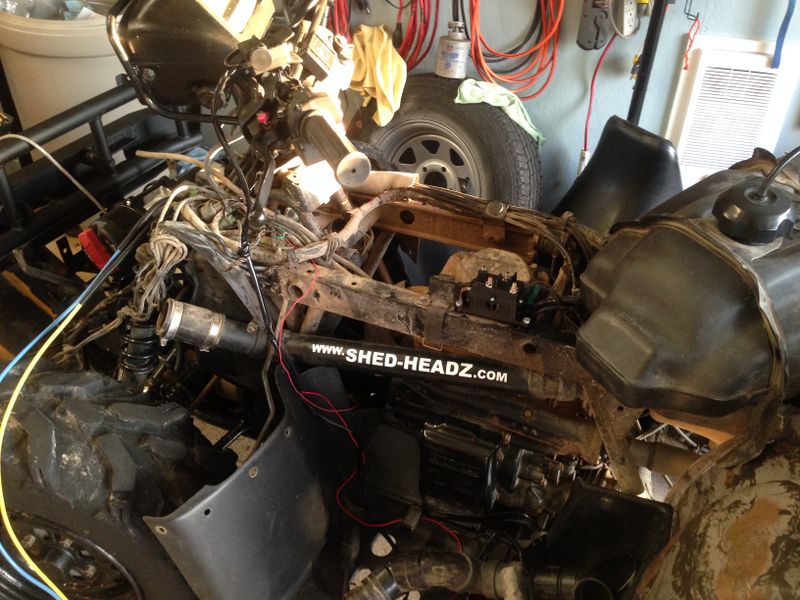
The only change I made since the original installation was
cutting the pipe inside the fender and adding a silicone coupler. After the
original installation there was no way to remove the front plastics when working
on the bike, the rubber coupler now allows me to disconnect the snorkel pipe
with ease.
Other Tips:
For deep water crossings, there are some other things need to be addressed to
keep the bike running when submerged. All vent lines which on the Foreman include
front & rear differentials, front and rear drum brakes, gas tank, and carburetor all
need to be extended to a higher location. Some people extend them to the height of the handlebars, or
attach
them the top of the intake snorkel, I chose to extend and run them inside the
centre headlight pod. The over flow hose on the bottom of the
carburetor should not be extended to a higher location as it needs to gravity
drain if the carb overflows. (more on this later)
Next you will need to water proof all electrical connections, especially the
ignition system or it may stall when submerged. An application of dielectric
grease in the spark plug boot, and all electrical plugs (especially the ignition
coil) should keep things dry and running.
When fording deep water, you will need to plug off (temporarily) the
carburetor over flow tube. I have found that the stock check valve will
allow water to enter the bowl of the carb and stall the motor. A golf tee works
well, and be sure to always remove the
plug when you finish your ride. Leaving it plugged may cause problems while
transporting or storing your bike. If the float sticks, fuel will not drain and
instead will fill the cylinder and engine with gas possibly hydro locking it.
On the foreman, the crank case breather is attached directly
to the bottom of the air box. The problem is that any more then about
an inch of water in the air box, and you can get water directly into your engine
oil. I removed the stock breather hose and installed a longer hose that leaves
the air box, routes up over the carburetor intake boot, and back down to the
engine. This creates an upside down trap that will not allow
water to easily enter the engine.
I currently do not use an exhaust
snorkel, as long as the engine stays running water shouldnít enter through the
exhaust. The trick is to keep blipping the throttle at all times as the engine
could stall at idle when the exhaust is underwater. To alleviate this you can
temporarily turn up your idle setting on the carb, or fabricate and install an
exhaust snorkel.
What to do after sinking an ATV:
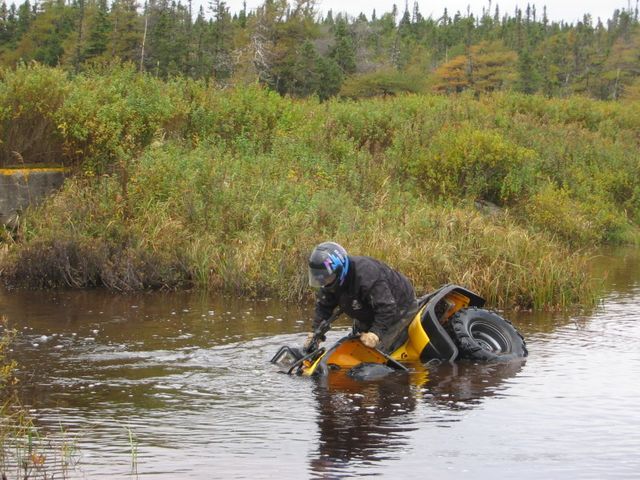
Since Iíve installed my Snorkel Iíve gotten the engine wet mostly from pushing
the limits of my design and rider skill. One time the bike floated, I lost my
balance and the bike tipped over.
-
As soon as you pull the bike from the
water DO NOT TRY TO START IT.
-
First stand the bike up to drain the muffler, then drain
the air box, and carburetor bowl (small screw bottom right side of
carburetor).
-
Be aware of the environmental implications of working on
your ATV in the woods. Don't drain gas or engine oil onto the ground, use an
empty pop bottle or other suitable container instead.
-
The air filter will most likely be wet and will have to
be dried before starting the engine.
-
Next remove the Spark Plug and turn
the engine over to eject any water that may
be on top of the piston.
-
Next check the oil level, most times it will be over full (from water
infiltration) and you could damage the motor even trying to start it. If
your deep water riding you should
always have spare equipment to do one or two oil changes in the woods, but a
simple trick is to remove the oil drain bolt, water is heavier than oil and
will run out first, when you see engine oil quickly reinstall the oil drain
plug. It will
not fix the problem but may get you home if you donít have far to go.
-
If you have a Honda automatic transmission I would not
risk riding the bike at all unless there is absolutely no other option.
These oil driven transmissions are expensive and don't like water.
-
If you have a CVT belt driven transmission you will need
to drain the belt drive box as well.
-
Once you
run the engine, the small amount of water remaining in the engine will turn the
oil milky grey in minutes.
-
If you have a CVT - Once the engine is running, put the
gearbox in neutral and run the engine at moderate to high RPM to spin and
dry the drive belt.
-
Now it's up to you to decide to ride the bike home or
tow, towing will guarantee that the engine is not damaged.
-
If the bike is running poorly or stalls after a short
time, re-drain the carburetor and check the gas tank vent hose, if it has
water inside it wont allow the tank to vent. You can test this latter theory
by unscrewing the gas cap and see if the stall problem is fixed.
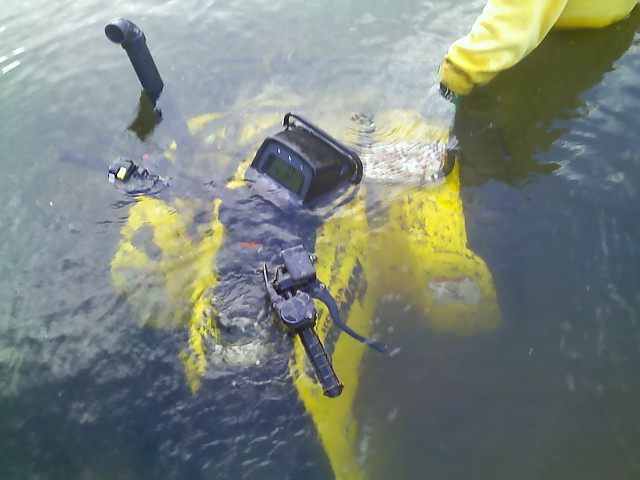
Once you get home:
-
If the bike was submerged in clear water you will need to
complete multiple oil changes with cheap motorcycle rated engine oil. Drop
the oil, refill, run the engine for 5-10 mins, then check to see if oil is
turned milky, if yes repeat oil change. You may have to repeat this 5-10
times. Perform one final oil change with your normal ATV oil and install a
new oil filter at that time.
-
If the bike was submerged in muddy, dirty water my best
recommendation is to remove the engine and split the engine cases for
cleaning as muddy sediment will remain inside the motor and do serious
damage to bearings inside over time.
-
Next remove the seat and put it somewhere warm to drain
and dry as the seat foam will be water logged.
-
Check both differentials for water infiltration and
drain/refill if needed.
-
If your bike has a Hi-Low-Reverse gearbox with a CVT belt
driven transmission then the gearbox oil will need to be changed.
-
Remove the CVT cover for inspection and cleaning of the
clutches - especially if submerged in muddy water.
Things to remember:
1. When the bike is submerged, large ATV tires will cause the bike float which
will reduce traction and can make the bike very tippy so be careful and keep
your balance.
2. Never cross an area that you are unsure about, and be aware of underwater
currents that may drift a partially floating ATV into danger.
3. If your riding an ATV in deep water, your going to get very wet yourself.
Beware that the water may be cold so dress accordingly and beware of hypothermia, its symptoms,
and necessary first aid.
4. Before you leave home, become familiar with the location of all necessary
drains, spark plugs and practice the steps above at home. Equip the bike with
all tools you need to complete the work listed above in the woods. Inspect the
carburetor drain screw and operate it to ensure it's not seized.
5. Be aware of the environmental implications of working on your ATV in the
woods. Don't drain gas or engine oil onto the ground, use an empty pop bottle or
other suitable container instead.
6. Have enough oil to perform at least one oil change in the woods if you sink
the engine.
7. Sometimes during deep water riding (or heavy rain) the vent hose for the fuel tank may plug
causing the bike to stall (similar to running out of fuel). To check open the
gas cap to let air in if the stalling is fixed you found the problem. Next
tighten the cap
then remove the vent hose and blow through it to dislodge any debris. Do not put the hose
in the hole near the handlebars if there is water at the bottom of that hole
just leave it loose to one side or the other.
8. Deep water riding should be considered an extreme sport as it certainly is
not the norm. Like all extreme riding, there are always additional risks so ride safe,
have the right equipment, and never ride alone.
Cheers, MIKE


